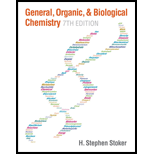
Concept explainers
(a)
Interpretation: To identify the structural subunits
a.
b.
Concept introduction: Coenzymes are non-protein organic compounds that are used along with the enzymes and help to carry forward the reaction. Coenzymes cannot perform on their own alone.
(b)
Interpretation: To identify the structural subunits
Concept introduction: Coenzymes are non-protein organic compounds that are used along with the enzymes and help to carry forward the reaction. Coenzymes cannot perform on their own alone.
Want to see the full answer?
Check out a sample textbook solution
Chapter 23 Solutions
GENERAL,ORGANIC,+BIO.CHEM.-MINDTAP
- AMP is derived from a reaction involving which of the following? ATP and ADP ADP and ADP NAD and FAD ATP and ATParrow_forwardWhat did NAD+ help do in reactions? (Pick ALL the correct possible answers) Select one or more: a. NAD+ acts as a coenzyme helping to work with an enzyme to create a reaction b. NAD+ is a made from Niacin (Vitamin B3), this is part of the reason why the B complex of vitamins helps you produce energy c. NAD+ removes hydrogen from other molecules d. NAD+ adds hydrogen to other molecules e. NAD+ helped to detoxify cells of ethanol by removing hydrogen making acetaldehyde and acetyl-COAarrow_forwardExplain which of the following substances ATP, CoA-SH, FAD and NAD+ have the subunits in their structure? A.Have 2 two ribose subunits.arrow_forward
- Which of the following factors favor fatty acid synthesis in liver cells when blood glucose levels are way higher than 10 mM? a.high NADPH and high NADH b low NADPH and low NADH c low NADPH and low NAD+ d high NADPH and high NAD+arrow_forwardWhich answer choice describes the process in the equation ATP+ H2O—->AMP+PP?arrow_forwardWhat is NAD and NADH and why are they important?arrow_forward
- Suggest a name for the enzyme that catalyzes each of the following reactions. a. transfer of a phosphate from ATP to glycerol b. addition of water to fumarate c. isomerization of glucose 6-phosphate to fructose 6-phosphatearrow_forwardWhich of the following statements about folic acid is not true? a. Folic acid is activated by folate synthase. b. Folic acid structure contains a pteridine ring and para-amino benzoic acid. c. NADPH is required in the reactions activating folic acid. d. Tetrahydrofolate is the biologically active derivative of folic acid.arrow_forwardExplain which of the following substances ATP, CoA-SH, FAD and NAD+ have the subunits in their structure? D.Have four different types of subunits.arrow_forward
- What type of reaction is: NADH --> NAD+ + H+ + 2 e-arrow_forwardWhich one of the following buffers the concentration of ATP? Select one: a. Glycolysis b. Acidosis O c. Phosphocreatine O d. Oxidative phosphorylation e. Acetyl coenzyme Aarrow_forwardDetermine the number of moles of NADH, FADH2, and ATP molecules that can be synthesized from 1 mol of stearic acid.arrow_forward
 Human Anatomy & Physiology (11th Edition)BiologyISBN:9780134580999Author:Elaine N. Marieb, Katja N. HoehnPublisher:PEARSON
Human Anatomy & Physiology (11th Edition)BiologyISBN:9780134580999Author:Elaine N. Marieb, Katja N. HoehnPublisher:PEARSON Biology 2eBiologyISBN:9781947172517Author:Matthew Douglas, Jung Choi, Mary Ann ClarkPublisher:OpenStax
Biology 2eBiologyISBN:9781947172517Author:Matthew Douglas, Jung Choi, Mary Ann ClarkPublisher:OpenStax Anatomy & PhysiologyBiologyISBN:9781259398629Author:McKinley, Michael P., O'loughlin, Valerie Dean, Bidle, Theresa StouterPublisher:Mcgraw Hill Education,
Anatomy & PhysiologyBiologyISBN:9781259398629Author:McKinley, Michael P., O'loughlin, Valerie Dean, Bidle, Theresa StouterPublisher:Mcgraw Hill Education, Molecular Biology of the Cell (Sixth Edition)BiologyISBN:9780815344322Author:Bruce Alberts, Alexander D. Johnson, Julian Lewis, David Morgan, Martin Raff, Keith Roberts, Peter WalterPublisher:W. W. Norton & Company
Molecular Biology of the Cell (Sixth Edition)BiologyISBN:9780815344322Author:Bruce Alberts, Alexander D. Johnson, Julian Lewis, David Morgan, Martin Raff, Keith Roberts, Peter WalterPublisher:W. W. Norton & Company Laboratory Manual For Human Anatomy & PhysiologyBiologyISBN:9781260159363Author:Martin, Terry R., Prentice-craver, CynthiaPublisher:McGraw-Hill Publishing Co.
Laboratory Manual For Human Anatomy & PhysiologyBiologyISBN:9781260159363Author:Martin, Terry R., Prentice-craver, CynthiaPublisher:McGraw-Hill Publishing Co. Inquiry Into Life (16th Edition)BiologyISBN:9781260231700Author:Sylvia S. Mader, Michael WindelspechtPublisher:McGraw Hill Education
Inquiry Into Life (16th Edition)BiologyISBN:9781260231700Author:Sylvia S. Mader, Michael WindelspechtPublisher:McGraw Hill Education





